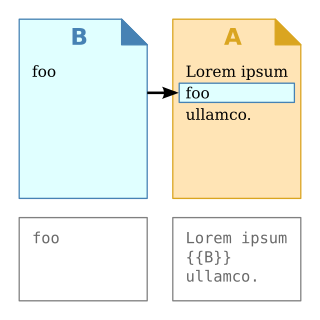Related Research Articles
Computer programming or coding is the composition of sequences of instructions, called programs, that computers can follow to perform tasks. It involves designing and implementing algorithms, step-by-step specifications of procedures, by writing code in one or more programming languages. Programmers typically use high-level programming languages that are more easily intelligible to humans than machine code, which is directly executed by the central processing unit. Proficient programming usually requires expertise in several different subjects, including knowledge of the application domain, details of programming languages and generic code libraries, specialized algorithms, and formal logic.

In computer science, transclusion is the inclusion of part or all of an electronic document into one or more other documents by reference via hypertext. Transclusion is usually performed when the referencing document is displayed, and is normally automatic and transparent to the end user. The result of transclusion is a single integrated document made of parts assembled dynamically from separate sources, possibly stored on different computers in disparate places.

In computer programming, a macro is a rule or pattern that specifies how a certain input should be mapped to a replacement output. Applying a macro to an input is known as macro expansion. The input and output may be a sequence of lexical tokens or characters, or a syntax tree. Character macros are supported in software applications to make it easy to invoke common command sequences. Token and tree macros are supported in some programming languages to enable code reuse or to extend the language, sometimes for domain-specific languages.
In computer science, pseudocode is a description of the steps in an algorithm using a mix of conventions of programming languages with informal, usually self-explanatory, notation of actions and conditions. Although pseudocode shares features with regular programming languages, it is intended for human reading rather than machine control. Pseudocode typically omits details that are essential for machine implementation of the algorithm, meaning that pseudocode can only be verified by hand. The programming language is augmented with natural language description details, where convenient, or with compact mathematical notation. The purpose of using pseudocode is that it is easier for people to understand than conventional programming language code, and that it is an efficient and environment-independent description of the key principles of an algorithm. It is commonly used in textbooks and scientific publications to document algorithms and in planning of software and other algorithms.
In computer science, control flow is the order in which individual statements, instructions or function calls of an imperative program are executed or evaluated. The emphasis on explicit control flow distinguishes an imperative programming language from a declarative programming language.

In computer science, an interpreter is a computer program that directly executes instructions written in a programming or scripting language, without requiring them previously to have been compiled into a machine language program. An interpreter generally uses one of the following strategies for program execution:
- Parse the source code and perform its behavior directly;
- Translate source code into some efficient intermediate representation or object code and immediately execute that;
- Explicitly execute stored precompiled bytecode made by a compiler and matched with the interpreter's virtual machine.
In software engineering and computer science, abstraction is the process of generalizing concrete details, such as attributes, away from the study of objects and systems to focus attention on details of greater importance. Abstraction is a fundamental concept in computer science and software engineering, especially within the object-oriented programming paradigm. Examples of this include:

John Warner Backus was an American computer scientist. He led the team that invented and implemented FORTRAN, the first widely used high-level programming language, and was the inventor of the Backus–Naur form (BNF), a widely used notation to define syntaxes of formal languages. He later did research into the function-level programming paradigm, presenting his findings in his influential 1977 Turing Award lecture "Can Programming Be Liberated from the von Neumann Style?"
Lexical tokenization is conversion of a text into meaningful lexical tokens belonging to categories defined by a "lexer" program. In case of a natural language, those categories include nouns, verbs, adjectives, punctuations etc. In case of a programming language, the categories include identifiers, operators, grouping symbols and data types. Lexical tokenization is related to the type of tokenization used in Large language models (LLMs), but with two differences. First, lexical tokenization is usually based on a lexical grammar, whereas LLM tokenizers are usually probability-based. Second, LLM tokenizers perform a second step that converts the tokens into numerical values.
Generic programming is a style of computer programming in which algorithms are written in terms of data types to-be-specified-later that are then instantiated when needed for specific types provided as parameters. This approach, pioneered by the ML programming language in 1973, permits writing common functions or types that differ only in the set of types on which they operate when used, thus reducing duplicate code.
Copy-and-paste programming, sometimes referred to as just pasting, is the production of highly repetitive computer programming code, as produced by copy and paste operations. It is primarily a pejorative term; those who use the term are often implying a lack of programming competence and ability to create abstractions. It may also be the result of technology limitations as subroutines or libraries would normally be used instead. However, there are occasions when copy-and-paste programming is considered acceptable or necessary, such as for boilerplate, loop unrolling, languages with limited metaprogramming facilities, or certain programming idioms, and it is supported by some source code editors in the form of snippets.

Code or text folding, or less commonly holophrasting, is a feature of some graphical user interfaces that allows the user to selectively hide ("fold") or display ("unfold") parts of a document. This allows the user to manage large amounts of text while viewing only those subsections that are currently of interest. It is typically used with documents which have a natural tree structure consisting of nested elements. Other names for these features include expand and collapse, code hiding, and outlining. In Microsoft Word, the feature is called "collapsible outlining".
In computer programming, a software framework is an abstraction in which software, providing generic functionality, can be selectively changed by additional user-written code, thus providing application-specific software. It provides a standard way to build and deploy applications and is a universal, reusable software environment that provides particular functionality as part of a larger software platform to facilitate the development of software applications, products and solutions.
Boilerplate may refer to:
A general-purpose macro processor or general purpose preprocessor is a macro processor that is not tied to or integrated with a particular language or piece of software.
In computer programming, boilerplate code, or simply boilerplate, are sections of code that are repeated in multiple places with little to no variation. When using languages that are considered verbose, the programmer must write a lot of boilerplate code to accomplish only minor functionality.

Snippet is a programming term for a small region of re-usable source code, machine code, or text. Ordinarily, these are formally defined operative units to incorporate into larger programming modules. Snippet management is a feature of some text editors, program source code editors, IDEs, and related software. It allows the user to avoid repetitive typing in the course of routine edit operations.
Template may refer to:

In computing, a compiler is a computer program that transforms source code written in a programming language or computer language, into another computer language. The most common reason for transforming source code is to create an executable program.
In computer science, bare machine refers to a computer executing instructions directly on logic hardware without an intervening operating system. Modern operating systems evolved through various stages, from elementary to the present day complex, highly sensitive systems incorporating many services. After the development of programmable computers but prior to the development of operating systems, sequential instructions were executed on the computer hardware directly using machine language without any system software layer. This approach is termed the "bare machine" precursor to modern operating systems. Today it is mostly applicable to embedded systems and firmware with time-critical latency requirements, while conventional programs are run by a runtime system overlaid on an operating system.
References
- ↑ "boiler plate", Merriam-Webster Dictionary (online)
- ↑ Boilerplate, Dictionary.com
- ↑ "Building that was home to boilerplate to become luxury condos" . Retrieved 2024-02-05.
- ↑ Lämmel, Ralf; Jones, Simon Peyton (2003). "Scrap your boilerplate: a practical design pattern for generic programming". Proceedings of the 2003 ACM SIGPLAN International Workshop on Types in Languages Design and Implementation. TLDI '03. New York: ACM. pp. 26–37. doi:10.1145/604174.604179. ISBN 9781581136494. S2CID 9472305.